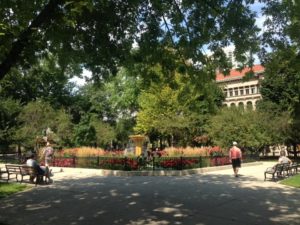Each month, a researcher shares their experiences of using a particular archive. The overall aim of this section is to create a database of the different archives available to those working on French and Francophone studies that will be of help particularly to students just starting out in research.
Antonia Perna is a PhD candidate in History at Durham University. Her thesis explores the ways in which children and adolescents participated in the political culture of the French Revolution. Antonia has recently undertaken a short-term research exchange fellowship at the Newberry Library, Chicago, and the John Rylands Research Institute, Manchester. Here she talks about the Newberry Library.

If, like me, you’re studying French history and based in the United Kingdom, Chicago probably isn’t the first place you’d think to find primary sources. Yet there, below the soaring skyscrapers that dominate the city skyline, overlooking the oasis of verdant tranquillity that is Washington Square Park, sits the Newberry Library. This world-famous independent research library was founded in 1887, and its pink granite, Richardson Romanesque exterior houses several collections of use to French historians. These include collections of French pamphlets dating from the sixteenth to the nineteenth century, along with manuscript collections in which the Revolutionary and Napoleonic periods are particularly well represented. Other strengths of the collections include American History and Culture, American Indian and Indigenous Studies and History of the Book. Descriptions of the Newberry’s collections can be found here: https://www.newberry.org/research-guides.
For scholars of the French Revolution, the Newberry is an invaluable resource. The French Revolution Collection (FRC) contains over 30,000 pamphlets and numerous periodicals dating from 1780 to 1810, which came into the Newberry’s possession in the mid-twentieth century. The bulk of these pamphlets have recently been digitized and are freely available online (https://archive.org/details/newberryfrenchpamphlets). This is an excellent resource, which not only makes these documents accessible internationally, but is also particularly useful for its text search feature. Nevertheless, nothing beats seeing the original documents and studying them alongside those which haven’t been digitized.
As a Newberry Library–John Rylands Research Institute Exchange Fellow, I was lucky enough to spend a month using the Newberry’s collections for my doctoral research. Researching French Revolutionary childhood, I worked primarily with the FRC. Reports I found here on Revolutionary youth festivals and school awards ceremonies at the écoles centrales revealed some of the ways in which children and adolescents participated in civic life in the later 1790s, and I was able to begin compiling a corpus of juvenile speeches at these events.
Regarding practical arrangements, reader registration is free and requires you to create an online account ahead of your visit, to which you then bring ID and proof of address. You can search the catalogue and request documents online through Aeon, the Newberry’s electronic request system. Once you have chosen a desk in the right reading room, staff will bring your documents to you, and you can keep as many as you need on hold—which is a great help if you’re looking at large numbers of individual pamphlets! Readers are allowed to photograph documents; the library will also make copies at a cost. Be sure to check opening times before you go: the reading rooms are closed on Mondays, for instance.
I mostly worked in Special Collections, which is where all pre-nineteenth-century material, as well as other rare books and maps, are consulted. For conservation purposes, this reading room is kept very cold, so even if you’re visiting in the summer, I would strongly recommend bringing a jumper! There is a cloakroom and lockers downstairs, with key codes so you don’t need to bring change. If the main locker room is busy, there is a second one on the lower-ground floor by the back entrance. The gift shop and free exhibitions on the newly-renovated ground floor are also well worth a look, and the library hosts regular public talks—make sure you register online in advance to attend these.
The Newberry Library does not have a café, but it is situated in downtown Chicago, with various restaurants, cafés and supermarkets nearby. Chicago is known for its cuisine, including local specialties such as the deep-dish pizza, and a wealth of great international culinary delights, so do take advantage of this! Useful information on dining and accommodation can be found on the Newberry website (https://www.newberry.org/accommodations-and-dining). Located on Chicago’s Near North Side, the library is easily accessible by ‘L’ train or bus; the nearest international airport is Chicago O’Hare, which has easy rail connections into the city.
Thank you very much for this, Antonia!


